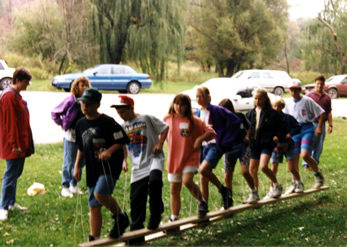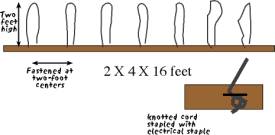Board Walking - Team Building Activity & Teaching Suggestions

Concepts
- Teams work together better if they communicate.
- Communication is between two people.
- Communication can help people learn.
- Practice can improve what you do.
Outcomes
- Teams will enjoy working together and achieving something they thought would be a difficult task.
- Teams will discover strategies of communication that will improve their ability to achieve.
- Teams will discover they can improve with practice.
Focus Questions
- What does it mean to work as a team?
- Do you think that you can get better doing something if you practice?
Materials:
Two sixteen foot 2X4’s with clothes line cord attached every two feet.

Background information
Team building is an effort in which a team studies its own process of working together and acts to create a climate that encourages and values the contributions of team members. Their energies are directed toward problem solving, task effectiveness, and maximizing the use of all members' resources to achieve the team's purpose. Sound team building recognizes that it is not possible to fully separate one's performance from those of others.
Characteristics Of Good Team Building
- High level of interdependence among team members
- Team leader has good people skills and is committed to team approach
- Each team member is willing to contribute
- Team develops a relaxed climate for communication
- Team members develop a mutual trust
- Team and individuals are prepared to take risks
- Team is clear about goals and establishes targets
- Team member roles are defined
- Team members know how to examine team and individual errors without personal attacks
- Team has capacity to create new ideas
- Each team member knows he can influence the team agenda
Team Effectiveness
When evaluating how well team members are working together, the following statements can be used as a guide:
- Team goals are developed through a group process of team interaction and agreement in which each team member is willing to work toward achieving the goals.
- Participation is actively shown by all team members with roles being shared to facilitate the accomplishment of tasks and develop feelings of group togetherness.
- Feedback is asked for by members and freely given as a way of evaluating the team's performance and clarifying both feelings and interests of the team members.
- When feedback is given it is done with a desire to help the other person.
- Team decision-making involves a process that encourages active participation by all members.
- Leadership is distributed and shared among team members and individuals willingly contribute their resources as needed.
- Problem solving, discussing team issues, and critiquing team effectiveness are encouraged by all team members.
- Conflict is not suppressed.
- Team members are allowed to express negative feelings and confrontation within the team, which is managed and dealt with by team members.
- Dealing with and managing conflict is seen as a way to improve team performance.
- Team member resources, talents, skills, knowledge, and experiences are fully identified, recognized, and used whenever appropriate.
- Risk taking and creativity are encouraged.
- When mistakes are made, they are treated as a source of learning rather than reasons for punishment.
Rating Your Team
How do you feel about your team's progress? (Circle your rating).
1. Team's purpose
I'm uncertain of the purpose <- 1 2 3 4 5 -> I'm clear of the purpose
2. Team membership
I felt like a member <- 1 2 3 4 5 -> I didn't feel like a member
3. Communications
Little and not helpful <- 1 2 3 4 5 -> Very appropriate and helpful
4. Team goals
Set outside the team <- 1 2 3 4 5 -> Developed by the team's interaction
5. Use of team member's skills
Poor use <- 1 2 3 4 5 -> Good use
6. Support
Little help from all members 1 2 3 4 5 High level of support from all members
7. Conflict
Difficult issues are avoided <- 1 2 3 4 5 -> Problems were discussed openly and directly
8. Decisions were made
By few members <- 1 2 3 4 5 -> By all members
9. Risk taking
Was not encouraged or supported <- 1 2 3 4 5 -> Encouraged and supported
10. Effort to have positive relationships with all team members
Little effort <- 1 2 3 4 5 -> High level of effort
11. Distribution of leadership
One person dominated <- 1 2 3 4 5 -> Shared
12. Useful feedback
Very little <- 1 2 3 4 5 -> Considerable
The proactive approach manifests characteristics as:
- The team members take a very positive approach in jointly determining the way they are going to work together as a team and what they want to have happen. When individuals and the entire team choose to operate this way and are willing to set petty differences aside, unbelievable results become possible.
- When individuals adopt this attitude and commit to use their resources, knowledge, and skills to contribute to the goals of the team, alignment with the team's overall purpose comes about. This will not happen unless both the team leader and team members choose to do so.
- Having a well-defined purpose or vision of what the team will accomplish is a very powerful force for the team leader and members. Goals are aligned with the team purpose, and team members are empowered to accomplish the goals. This process leads to a high level of team productivity.
- Team members have a positive attitude toward change and are willing to accept and allow change to occur as needed in order to accomplish desired results.
- Team members understand that patience is required, and that for some goals, a long-term commitment is needed to accomplish the desired results.
- Interests of both the team leader and team members are focused on desired results rather than on short-term problem- solving activities.
- If people learn to focus simultaneously on both the current situation and the desired results, problems that arise will be solved as part of the total process of achieving the desired results.
- The members have a strong feeling of control within the team. They are able to establish priorities and then commit time and resources for accomplishing these tasks.
- Team members verbally and publicly support each other. They recognize that negative comments about others tear the team down.
- Team leaders and members that make a conscious, sustained effort to make these characteristics a part of their mind set will find that both creativity and accomplishment of desired results will be much higher than it would be otherwise.
SOME INTERESTING FACTS:
- When you’re in the middle of a problem, it’s sometimes difficult to see the solution.
- Everybody needs to be a part of the solution. Teams are interdependent.
- Everyone has their own perspective from where they stand.
Activity Team buildingf
- Begin a discussion about what a team is.
- Tell the students that they will be doing an activity as a team that is challenging and will give them some ideas about team work and how teams can cooperate to achieve their goals.
- Present the challenge of board walking.
- Let the students try to walk from one point to another.
- After the students arrive at the designated point, discuss their team work.
- Share ideas with the team about what they did well, a handout, see background information, and ask for ideas to return to the starting position.
- When the team arrives at the beginning point ask them to evaluate their performance against whatever criteria or guidelines that were used.
- Determine if there are areas in which the team members could improve and accept suggestion for doing so.
- Continue until…
- I have observed teams that were able to literally jog on these boards. That’ team building.